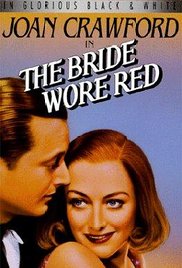
THE BRIDE WORE RED
US, 1937, 103 minutes, Black and white.
Joan Crawford, Franchot Tone, Robert Young, Billie Burke, Reginald Owen, Lynne Carver, George Zucco, Mary Phillips, Dickie Moore.
Directed by Dorothy Arzner.
This is something of a 1930s fairytale, set in the Italian city of Trieste and then in a mountain resort in Italy. It is the story of an impoverished singer who, by chance, is chosen by an extravagant Count (George Zucco) for an experiment to test whether people are the same whether they are rich or poor. He pays for her to spend two weeks, all expenses paid, in the Italian resort – and she accepts.
The singer was played by Joan Crawford who was establishing herself as a more important star by the mid-1930s. She co-stars with Robert Young and with Franchot Tone (her one-time husband). In the supporting cast is Billie Burke, a touch less flighty than usual, and Reginald Owen as an Admiral. Joan’s performance is a blend of charm and hardness.
The film is based on a play by the prolific Ferenc Molnar (films based on his plays include Carousel, Breath of Scandal and One, Two, Three).
One of the most important factors in the film is that it was directed by Dorothy Arzner, the only woman director in Hollywood from the 1920s to the 1940s, a member of the Directors Guild when it was established, directing some silent films and 14 sound films including Christopher Strong with Katharine Hepburn. From the 1960s until her death in 1979, she taught at UCLA.
1. MGM films of the 1930s, romantic dramas, comic touches, fantasy?
2. MGM production values, black and white photography, the city of Trieste? The resorts, the hotels? The scenery? Into Italy, the mountains, the lakes? The musical score?
3. The film as a Joan Crawford vehicle, her status at this time? in Trieste, the singer, hungry, the meeting with the Count, the meal and her wanting meat, his offer, her acceptance? Going shopping, travelling, not met at the station, Giulio and his cart, talking with her, the hotel, the manager and his behaviour, pleasing the Count? Giulio’s cousin and serving her? The room, finding Maria, the bond between the two, the talk and memories, her pretence, and enjoying the situation? For two weeks?
4. The dining room, the Admiral and his sending the note, her tearing it up, his approach? Going to the table? The Countess and her suspicions?
5. Giulio, the postman, his father in the job, cheerful man, his cousin and eating blackberries instead of delivering telegrams, his work, the attraction, the music and the Festival, his many cousins?
6. Rudi, his behaviour in Trieste, the playboy, with women? His friendship with the Count? At the resort, with the Countess, the Admiral, with Maddelena, her being in love with him? The upper-class? With Ann, suspicions, the Admiral remembering stories from the past, the Countess sending the telegram, its eventual arrival?
7. Rudi, with Maddelena, with other women, attraction and, going out with her, sharing, and ambitions, what she wanted? Maria urging her to reality? Her decision about marrying, tough stances?
8. Her visits to Giulio’s office, nature, generally, sense of freedom? And Giulio delaying the telegram?
9. Ann, in love with Giulio, his knowing the truth, his reaction?
10. Rudi, determined to marry, the red dress, wearing it in public, Maddelena being very nice to her? The decision to go, wearing the red dress, given to Maria, hearing the music from the restaurant, shutting the door, packing – and then the exposé, her reaction, the Admiral and stories, to the Countess, and
always nice to Maddelena?
11. Her wanting to see the pines – and Giulio giving her a lift again?